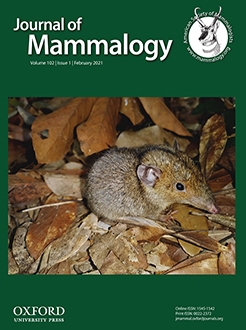In human-dominated landscapes throughout the world, wildlife seek out anthropogenic foods because they are high in nutritional value and are consistently available. To investigate this mode of foraging, some researchers use stable isotope analysis to detect these animals in populations and estimate their individual diets. In this study, we develop an integrative approach to measure the proportion of corn, a C4 plant, in the diets of free-ranging mammalian omnivores in C3-dominated ecosystems. We fed captive mice corn, C3 plants, and meat until carbon stable isotopes (δ13C) from each diet equilibrated in their hair. We then used carbon discrimination factors (Δ13C; offsets between stable isotope values of consumer tissues and their foods) for mice from these feeding trials and a simple carbon stable isotope mixing model to estimate the corn-based diets of free-ranging American black bears in Wisconsin and brown bears in Slovenia. We used Δ13C factors for mice to estimate the diets of bears because mouse models are used commonly to study mammalian diet and health, including humans and bears, and body mass has no effect on carbon discrimination factors in monogastric mammalian omnivores. In this study, we found that mice grew fastest, largest, and δ13C values equilibrated quickest in the hair of mice fed meat versus plant-based diets, suggesting protein quantity (quality was the same) has an effect on Δ13C. Evidence also suggests that Δ13C did not increase with animal growth rate as all mice grew throughout the 109-day feeding trials, but isotopic equilibration occurred early while mice still were subadults and was maintained throughout their adult lives. We also found that Δ13C was highest and most variable in the hair, serum, and liver, of mice fed a mixed diet of C3 plants, supporting our mixed diet hypothesis that states that Δ13C varies more among tissues of animals fed mixed diets than animals fed nonmixed diets because the former are composed of multiple foods, each with different macromolecular and isotopic compositions. Lastly, we found that corn may have been a more important component of bear diets in Wisconsin than previously thought (adults: x̄ = 29%; x̄ = 33%; subadults: x̄ = 22%; x̄ = 28%), and male brown bears may have fed on 50% more corn (x̄ = 47% versus 31%) in autumn during a year when beechnut availability was low. In a world that is rapidly changing, it is more important than ever to develop the appropriate quantitative tools to measure the impact people have on wildlife. Here, we provide such a tool for monogastric mammalian omnivores and encourage other researchers to do the same for other taxa of interest.
How to translate text using browser tools
22 January 2021
Measuring the impact of corn on mammalian omnivores
John B. Hopkins III,
Jake M. Ferguson,
Cheryl Frederick,
Klemen Jerina
ACCESS THE FULL ARTICLE

Journal of Mammalogy
Vol. 102 • No. 1
February 2021
Vol. 102 • No. 1
February 2021
anthropogenic foods
black bears
brown bears
carbon stable isotopes
corn
IsotopeR
isotopic discrimination factors




